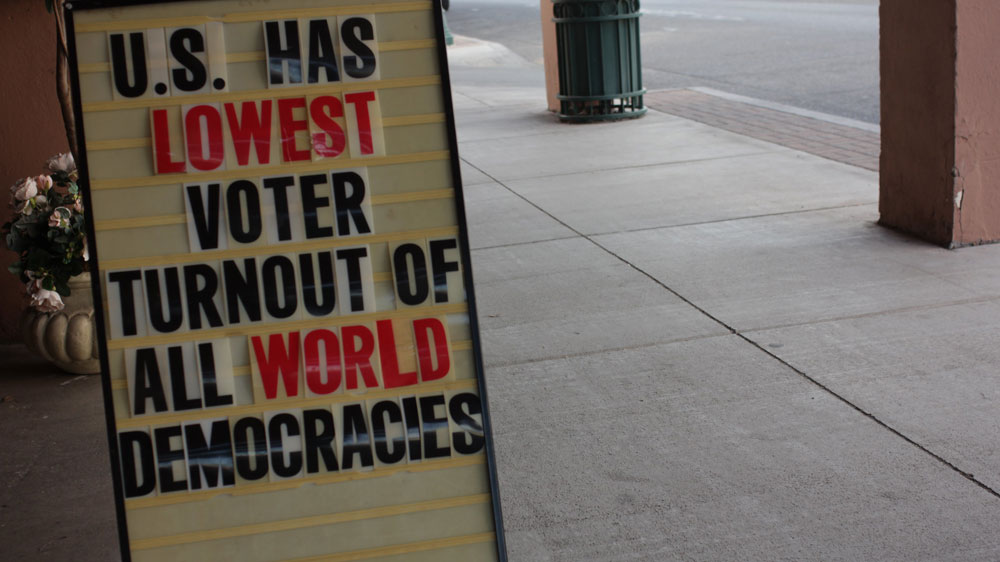
November 5, 2020; Time
What if an election were held and everyone voted? This was a question the Knight Foundation asked earlier this year in a report titled The 100 Million Project: The Untold Story of American Non-Voters. And while not everyone voted in 2020, a surprisingly high two-in-three eligible US voters did.
Indeed, the turnout increase was dramatic enough—the number of voters increased from 137.5 million to 2016 to close to 160 million this year—that, among other things, it provides an intriguing test of whether increased turnout benefits one party or the other. The Knight study suggested that non-voters were split in their political views pretty much the same as voters, and that an overall increase in turnout would do little to shift the political balance of power.
By and large, the 2020 election results confirm that finding, but as NPQ noted when reviewing the Knight report, “It is who turns out that matters the most.” One statistic that might have shifted just enough to change the presidential election outcome is the following: in 2016, 29 percent of voters were people of color; in 2020, 33 percent were.
But if this year’s 67-percent turnout is impressive, look at these turnout numbers from US elections held in the last third of the nineteenth century:
| 1868 | 78.1% |
| 1872 | 71.3% |
| 1876 | 81.8% |
| 1880 | 79.4% |
| 1884 | 77.5% |
| 1888 | 79.3% |
| 1892 | 74.7% |
| 1896 | 79.3% |
| 1900 | 73.2% |
Yet in the twentieth century, US voter turnout plummeted. By the time Franklin Delano Roosevelt trounced Herbert Hoover in the 1932 election—an election one might consider pretty high stakes, given that it was held at the depth of the Great Depression—turnout was a modest 52.6 percent, slightly lower than the pre-2020 numbers we had been accustomed to seeing.
What happened? The short answer is a combination of racism and the exploitation of anti-immigrant sentiment.
To understand this, note that elections in the late nineteenth century weren’t just about doing your civic duty—they were civic events. Historian Eric Foner tells Time Magazine’s Olivia Waxman that political figures of the era, like Henry Clay and James G. Blaine, “were like national celebrities, like movie stars, TV personalities, sports figures.”
Sign up for our free newsletters
Subscribe to NPQ's newsletters to have our top stories delivered directly to your inbox.
By signing up, you agree to our privacy policy and terms of use, and to receive messages from NPQ and our partners.
On election day, Waxman adds, “The liquor flowed, and people dressed up to see and be seen. People also voted publicly, and a glass ballot box was designed to show that votes were being counted and assuage fears of fraud.” With open, not secret, voting the norm, reformers responded to the potential (and sometimes reality) of people being pressured to vote for one candidate or another by implementing safeguards, such as the secret ballot.
Yet the reforms were not just “meant to prevent corruption; they were also meant to prevent certain people from voting, especially immigrants and people of color.” In the South, white elites used violent intimidation and Jim Crow laws such as poll taxes and blatantly unfair “literacy” tests to forcibly suppress the Black vote.
As Jon Grinspan, historian at the National Museum of American History and author of the forthcoming The Age of Acrimony: How Americans Fought to Fix Their Democracy, 1865-1915, points out, the push to lower voter turnout was intentional, both in the South and the North.
“There is a big culture of huge turnout in the late 19th century, and it’s mostly kind of working-class Americans, immigrants, and urban Americans,” Grispan tells Waxman. “The upper class doesn’t like the idea of a political system dominated by these political machines that are made up of Irish, German, Jewish immigrants run out of saloons in the cities.”
As a result, rules like voter registration became the norm. As Waxman puts it, “By World War I, northern states like New York, Oregon, Pennsylvania, and Indiana adopted procedures that made voting and registering to vote more of a pain.”
But a silver lining, reinforced by this year’s extraordinary turnout, suggests that, despite continued voter suppression, the trend may be changing. “Since 2004, we’ve been at the higher range of turnout over the past century of our politics,” says Michael McDonald, a University of Florida political scientist who runs the United States Elections Project.
A host of factors are behind the recent recovery of voter turnout. Civic advocacy has been critical, and easier access to in-person early voting and mail ballots matters too. So too do efforts to restore the fun in voting—be that free pizza, line dancing, or circus shows. While many may prefer to vote by mail, for those who don’t, perhaps voting could even become a civic event once again.—Steve Dubb












